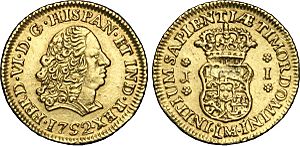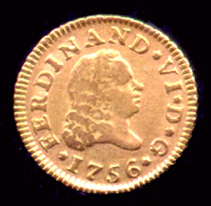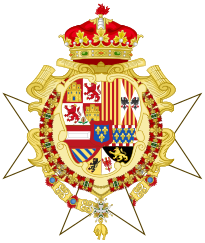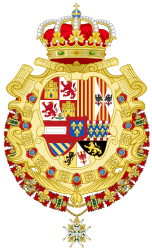Ferdinand VI of Spain facts for kids
Quick facts for kids Ferdinand VI |
|||||
|---|---|---|---|---|---|

Portrait by Louis Michel Van Loo, c. 1746-59
|
|||||
| King of Spain (more...) | |||||
| Reign | 9 July 1746 – 10 August 1759 | ||||
| Predecessor | Philip V | ||||
| Successor | Charles III | ||||
| Chief Ministers |
See list
|
||||
| Born | 23 September 1713 Royal Alcazar of Madrid, Madrid, Spain |
||||
| Died | 10 August 1759 (aged 45) Villaviciosa de Odón, Madrid, Spain |
||||
| Burial | Convent of the Salesas Reales | ||||
| Spouse | |||||
|
|||||
| House | Bourbon-Anjou | ||||
| Father | Philip V of Spain | ||||
| Mother | Maria Luisa of Savoy | ||||
| Religion | Roman Catholicism | ||||
| Signature | |||||
Ferdinand VI (born September 23, 1713, died August 10, 1759) was the King of Spain from 1746 until his death. People called him the Learned (el Prudente) and the Just (el Justo). He was the third king from the Bourbon family in Spain. His father was King Philip V, and his mother was Maria Luisa of Savoy.
During his time as king, Ferdinand VI kept Spain out of wars in Europe. He made some important changes in Spain. These included improving taxes, helping trade grow, and making the Spanish navy stronger. He also banned freemasonry. However, like his father, Ferdinand faced mental health challenges in his last years. After he died, his half-brother, Charles III, became the new king.
Contents
Early Life and Personality
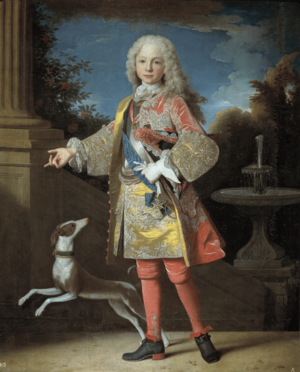
Ferdinand was born at the Royal Alcázar of Madrid. He had a difficult childhood. His stepmother, Elisabeth Farnese, was very powerful. She only cared about her own children. She saw Ferdinand as a problem for their future. His father, King Philip V, often felt unwell. This meant Elisabeth was in charge of the palace.
Ferdinand was naturally a quiet and shy person. He often felt sad and doubted himself. Once, when someone praised his shooting skills, he said, "It would be hard if there were not something I could do." Shooting and music were his only hobbies. He was a big supporter of the famous singer Farinelli. Farinelli's singing helped to cheer him up.
Marriage to Barbara of Portugal
In 1729, Ferdinand married Infanta Barbara of Portugal. She was the daughter of John V of Portugal and Maria Anna of Austria.
Ferdinand's Time as King
When Ferdinand became king in 1746, Spain was involved in the War of the Austrian Succession. This war ended without much benefit for Spain. One of his first actions as king was to reduce the influence of his stepmother and her Italian friends at court. As king, he decided that Spain would stay neutral. He avoided taking sides between France and Britain. He refused to join either side in their conflicts.
Important people during his reign included the Marquis of Ensenada. He was a supporter of France. Another key figure was José de Carvajal y Lancáster, who favored an alliance with Great Britain. Their rivalry ended in 1754 when Carvajal died. After that, Ensenada lost his position. Ricardo Wall then became the king's most trusted advisor.
Important Changes and Reforms
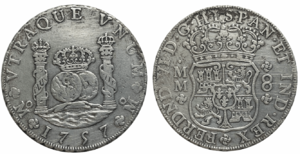
Many important changes during Ferdinand VI's reign were led by the Marquis of Ensenada. He was the Secretary of the Treasury, Navy, and Indies. Ensenada believed Spain needed to modernize to be strong. He thought this would help Spain be respected by France and Britain. He also wanted Spain to keep its claim to Gibraltar.
In 1749, Ensenada suggested a new tax system. He wanted to replace old taxes with a single tax called the cadastre. This tax would be based on how much property each person owned. He also wanted to reduce money given by the state to the Cortes (parliament) and the army. However, the nobility opposed this idea, so the plan was dropped.
In 1752, the Giro Real bank was created. This bank helped manage public and private money transfers outside Spain. It kept foreign money exchanges under the control of the Royal Treasury. This helped to make the state richer. It was a step towards the Bank of San Carlos, which was created later by Charles III.
Trade with the Americas was also encouraged. The goal was to end the old trade monopoly and fix unfair colonial trade practices. Ferdinand preferred using "registered ships" instead of large fleets. This new system allowed authorized Spanish ships to trade freely in the Americas. This increased income and reduced fraud. However, some private merchants were unhappy with this new system.
Ensenada believed a strong navy was vital for Spain's overseas empire. He thought it was necessary for Spain to be respected by France and Britain. He increased the navy's budget. He also expanded the shipyards in Cádiz, Ferrol, Cartagena, and Havana. This continued the naval improvements started by the previous king.
Relations with the Church had been difficult since the reign of Philip V. This was because the Pope recognized Charles of Austria as the King of Spain. Ferdinand VI continued a policy that gave the Crown more control over the Church. This led to the Concord of 1753. Through this agreement, Pope Benedict XIV gave the Crown the right to appoint church officials. This brought important financial benefits to the Crown and more control over the clergy.
King Ferdinand also helped establish the Royal Academy of the Fine Arts of San Fernando in 1752. The famous composer Domenico Scarlatti was the music teacher to Queen Barbara. He wrote many of his 555 harpsichord sonatas at Ferdinand's court.
Ban on Freemasonry
In 1751, Ferdinand VI banned freemasonry in Spain. This followed a ban by the Pope in 1738. However, during the reign of his half-brother, Charles III, freemasonry would slowly return to Spain.
Foreign Relations
During the War of the Austrian Succession and the Seven Years' War, Spain worked to strengthen its military.
A main issue was a disagreement with Portugal over the colony of Sacramento. British smugglers used this colony to bring illegal goods down the Río de la Plata. In 1750, José de Carvajal y Lancáster helped Spain and Portugal reach an agreement. Portugal agreed to give up the colony and its right to free travel on the Río de la Plata. In return, Spain gave Portugal two areas on the Brazilian border. These areas included seven of the thirty Jesuit Guaraní towns. The Spanish had to remove the missionaries, which led to a conflict with the Guaraní people that lasted eleven years.
This conflict over the towns caused problems in the Spanish Court. Ensenada, who supported the Jesuits, and Father Rávago, the King's confessor, were fired. They were accused of blocking the agreements with Portugal.
Death of the King
During his last year as king, Ferdinand VI's mental health quickly declined. He stayed at the Villaviciosa de Odón castle until his death on August 10, 1759. The period between August 1758 and August 1759 is sometimes called "the year without a king" in Spanish history. This is because the king was not able to rule effectively.
The exact cause of his illness is still debated. Some historians believe the king suffered from severe depression. The death of his wife, Barbara, deeply saddened him. She had been very devoted to him and stayed out of politics. After her death in August 1758, Ferdinand became very withdrawn. He would not even get dressed and wandered around his park in a nightgown. Other opinions suggest he had a brain condition. This condition caused changes in his behavior, apathy, poor judgment, and seizures.
Since Ferdinand and Barbara had no children, his half-brother, Charles III, became the next King of Spain.
King Ferdinand's Legacy
Historian Stanley G. Payne views Ferdinand VI positively. He wrote that Ferdinand's greatest strength was keeping Spain peaceful. He avoided getting Spain involved in more European wars. However, Payne also noted that Ferdinand's last five years were difficult. Like his father, he eventually suffered from mental illness. This led to a period of little action from the king.
Heraldry
- Heraldry of Ferdinand VI of Spain
-
Coat of arms as Infante of Spain
-
Coat of arms as Prince of Asturias
See also
 In Spanish: Fernando VI de España para niños
In Spanish: Fernando VI de España para niños
- Capítulo Noble de Fernando VI


